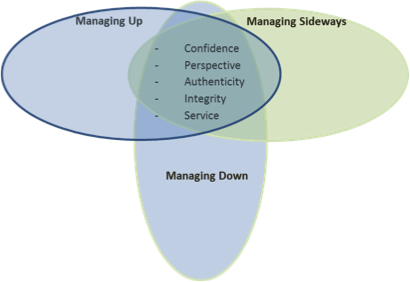We live in a results-driven society where management skills are just the beginning in driving organizations to meet challenging and high performing goals. Professionals are stretched daily to deliver top-notch performance. More often than not, professionals need to navigate complex organizational structures to achieve success, relying on and working with individuals and teams across various levels of an organization. How does one have positive influence over the work of others across all levels? Specifically, what does influential leadership look like when leading up, down, and sideways across an organization?
Joseph Rost, author of Leadership for the Twenty-First Century, believes that the word influence was the most often used word in defining leadership in the 1980’s. He claims that the notion of leadership as influence is one that clearly stands out (1993). These remain true today as well, however, the forces increasing the need for influence and related skills has drastically changed.
In the pursuit to uncover and define influential leadership, other core ideas related to influential leadership emerged: social influence, organizational change and change management, and management. Leadership is directly linked to social influence because without it, leadership does not occur. By definition, social influence is the process in which a person steers members of a group toward a goal. The social aspect of leadership allows for there to be a process of human interaction. It is true that some individuals are more skilled in this arena than others, as seen in the varying degrees of productivity within organizations world-wide (Rost, 1993). Although I don’t explicitly address transformational leadership, it is important to note that there are similarities and differences between to the two concepts. Influential leadership relies on influence as opposed to coercion, essentially creating followers who believe that they have to follow. Transformational leadership relies on transforming through empowerment, which is tied to profitability and results, but has the potential to create dependence on the leaders.
Organizational change and change management has a connection to influential leadership because with change comes the need to influence and get others onboard with the change or new direction. Influential leaders can help manage this change (Durant, 1999). Mirsalimi and Hunter believe that when leaders have presence, when others trust them, and when followers are influenced by them, desired results and an acceptance of change will likely follow from the team or organization. Essentially, without influential leaders, change and managing change in the workplace will be difficult, at best.
Finally, the difference between leadership and management. In the article, How Can We Train Leaders if We Do Not Know What Leadership Is Barker states, “The function of leadership is to create change while the function of management is to create stability” (1997, p. 349). Barker’s take on the differences suggests that leadership creates new patterns of actions—therefore promoting change. Management, on the other hand, stabilizes patterns, yet creates an environment that anticipates change. According to Green and Hauser, managers need to be more than just leaders who empower their people; they need to be more hands-on in clearly communicating their expectations for the outcomes of the work.
There is no one-size-fits-all approach to leadership. Influential leadership is just one term, among the many, to describe what is needed to keep up with the growing demands and complexities of the modern workforce. Importantly research is showing that leadership is not exclusive to only a few individuals within an organization; every employee has to display leadership abilities that will influence others to drive change and create positive outcomes. The health of an organization relies on its people and the productivity of each person.
Exercising the art of influence and leadership, according to Mirsalimi and Hunter, is when you “don’t wait to be told what to do, but you think about what needs to be done; when you think outside the box and influence others to do the same; when you think creatively and bring others onboard with your vision of how something should be done; when you look into the future and think about possibilities as opposed to obstacles, and inspire others to see the future in a similar manner, you are engaging in leadership no matter where you are in the organizational chart hierarchy” (2006, p. 76).
Hence, the competency checklist for an influential leader includes:
taking personal responsibility
embracing change
being a future thinker
taking risks
being a persistent problem solver and persuasive negotiator,
doing whatever it takes to have impact,
exhibiting resilience to setbacks,
enjoying challenges,
having a high need to achieve, and
constantly acquiring new knowledge and skill sets
(Ingbretsen Consulting, LLC (2013))
Applying these competencies to the concepts of managing up, managing down and managing sideways defines influential leadership in today’s ever-changing organizations. It is important to note that these three concepts of managing up, managing down, and managing sideways are similar from a skills-needed perspective, but unique in the structure for which the skills are applied.
It was believed that influential leadership cannot be taught, however, this isn’t true - influential leadership can be taught. In Part 2, I will share how coaching can support individuals move towards a state of influence where they are exercising leadership.
Donna Rossi Smith: Executive Excellence










